Yellow-billed Cuckoo (Coccyzus americanus)

Yellow-billed Cuckoo (Coccyzus americanus)
×


Yellow-billed Cuckoo (Coccyzus americanus)
About Yellow-billed Cuckoo (Coccyzus americanus)
- Kingdom: Animals
- Phylum: Chordates
- Class: Birds
- Order: Cuckoos
- Family: Cuckoos
The yellow-billed cuckoo is a member of the cuckoo family. Common folk names for this bird in the southern United States are rain crow and storm crow. These likely refer to the bird's habit of calling on hot days, often presaging rain or thunderstorms. The genus name is from the Ancient Greek kokkuzo, which means to call like a common cuckoo, and americanus means "of America".
Source: Wikipedia
Lifelists
Visits
-
2013-04-19
Bolivar Peninsula, United States of America -
-
-
-


